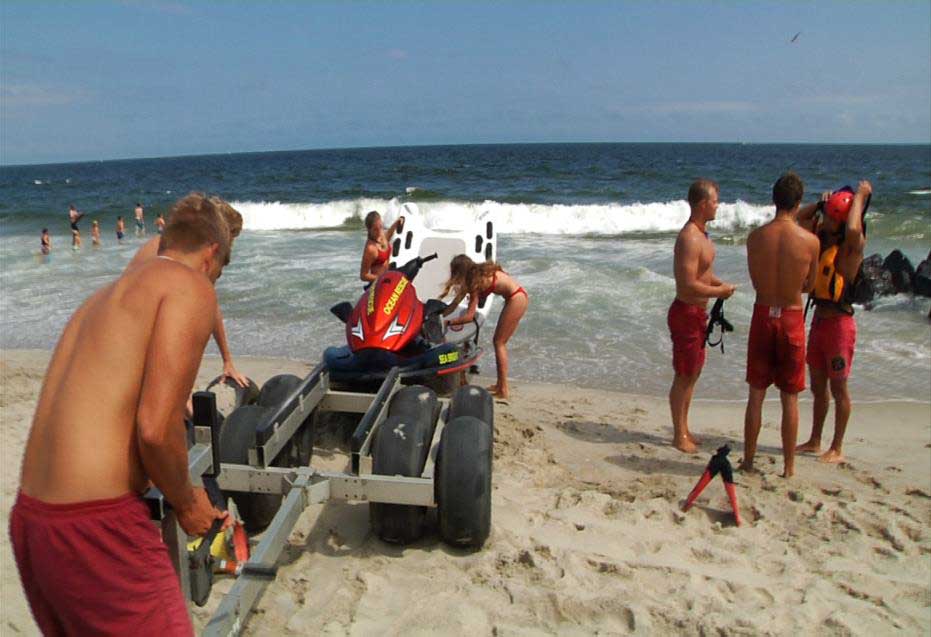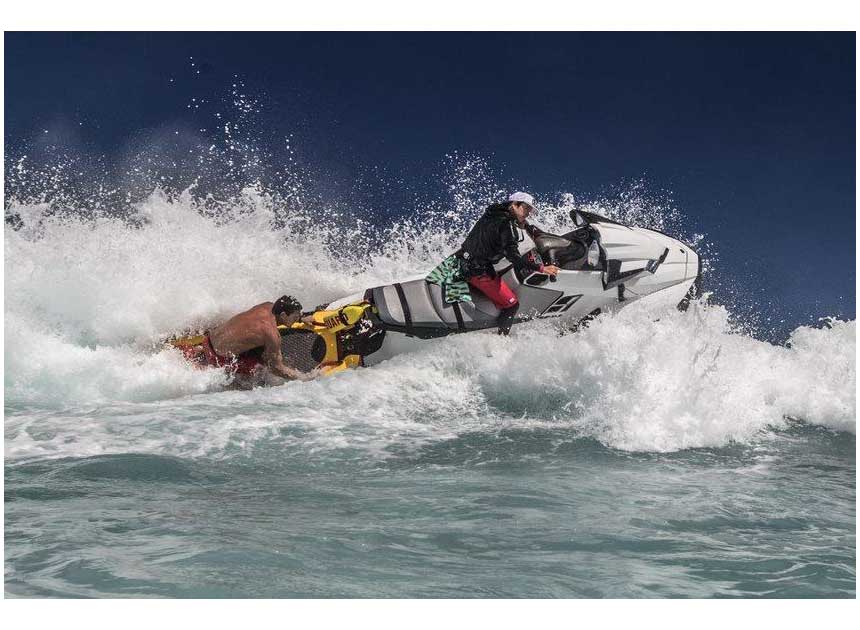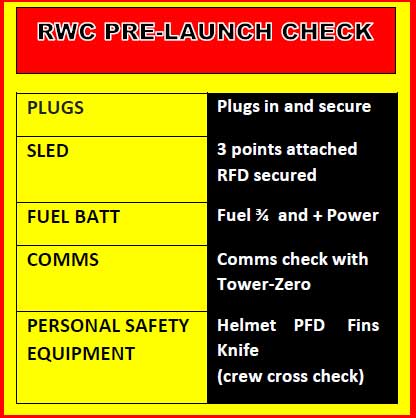
RWC Operations Risk Management
By Mike Hudson
On a typical, nondescript summer morning, a fire department water rescue team mulled through their morning preventative maintenance and checklists for its personal watercraft (PWC), which includes confirmation of hull integrity, including the insertion of the bilge’s hull plugs. After the checklist was completed, the rookie on the team was ordered to wash and rinse the inside and outside of the primary PWC, which requires the removal of the bilge plugs. Later that day, the team was dispatched to a water rescue “job” for multiple children caught in a rip current at a neighboring beach. Normally, the unwritten rule is to check the plugs before launching the PWC, but the crew deviated from that step and the craft was hastily launched into the four-foot surf; soon after, the engine compartment flooded, rendering the craft inoperable.

Normalization of Deviance
Practical drift or the “normalization of deviance” is a phenomenon that encompasses the gradual “drift” away from written procedure by modifying practices based on repetitive deviation that has no consequence.(1) The fire service’s culture of safety is not immune to normalization of deviance, and during high-risk/low-probability rescue operations, the deviation from procedure can be both deadly and costly. If a rescue team deviates from a standard procedure repeatedly by skipping tasks within the procedure and there are no subsequent consequences, that “drift” becomes the norm. High-risk missions with palpable urgency such as a colleague in peril or a submerged child causes physiological changes in the human body. The human factors influenced by the perceived urgency of an incident causes a stress response that may cloud judgement and push personnel to make bad decisions, such as skipping procedures in favor of saving time.
RELATED
The Sterile Cockpit Rule for Today’s Fire Service
Is the Fire Service Trading Effectiveness for Efficiency? Complacency and Normalization of Deviance
Firefighter Safety: The Normalization of Deviance
DeStefano: Don’t Get Too Comfortable
As defined by the Federal Aviation Administration (FAA), (2) human factors encompasses natural human behavior, psychology, technical skill, decision-making capabilities, and the effects that may change a pilot’s ability to communicate, operate machinery, perform procedures, and use technology. Human factors are especially influenced by heavy task loading and should be a major consideration during risk assessments and during accident investigations. Human factors are especially relevant to high-risk procedures and can influence the normalization of deviance (1).
In the above-described scenario, the catalysts for the team’s failure to check the plugs were the belief that the plugs were already good-to-go coupled with the adrenaline-fueled rush to launch for children in distress. In the mind of crewmembers, this justified the need to deviate from the “unwritten” rule. In the past, this crew had most certainly failed to check the plugs before launch, probably without consequence, but today their primary ski lay crippled and capsized in the impact zone. Although this was a fictional scenario, almost anyone who has ever owned a PWC has experienced problems with bilge plugs—it’s one of the most common factors that cause water damage to PWC engines and electrical systems.

Crew Resource Management
From 1972 to 2008, America’s medevac aviation programs had hundreds of helicopter accidents with fatalities and near misses attributed to human (pilot) error. Because of the hazards associated with helicopter EMS, the FAA developed formal risk management strategies and training taken from their Air Crew Resource Management (ACRM) program and created the Air Medical Resource Management Program (AMRM.) (3). The primary goal of AMRM is to increase aircraft safety from start to finish by addressing the causes of sentinel incidents. AMRM focuses on improving crew communication, addressing human-factors, safety training, and reliance on structured procedures during all phases of aircraft operation, even during patient care. The AMRM program dictates that medevac teams develop risk management procedures, giving priority to those flight operations that present the highest risk, such as launching and landing the aircraft. One of the risk management strategies developed was simple prelaunch and prelanding checklist procedures in which all crewmembers participate. AMRM has proven itself successful in managing the risk of helicopters auguring into the ground.
RWC Readiness and Risk Management Strategy
Launching a 900-pound PWC into the surf and the subsequent recovery of that craft pose the highest risk to crew and equipment. The National Fire Protection Association (NFPA) 1006, Standard for Technical Rescue Personnel Professional Qualifications, 21 3.1 (4) states the readiness of rescue watercraft (RWC) systems and ancillary safety equipment must be checked before launch. The NFPA also outlines the major factors that can hamper mission success, including human factors, hull integrity, engine power, fuel level, electrical systems, and communications. It is then logical to assume that these factors should be prioritized when drafting an RWC risk management plan. However, complicated checklist procedures can be quite tedious day after day. Based on “human factors,” personnel may drift towards modifying unnecessarily long procedures by abbreviating the tasks.
One method proven to manage risk for helicopter air medevac teams around the country is that pilots are required to complete a comprehensive readiness checklist at the start of every shift and then an abbreviated redundant checklist before every liftoff. This is intended to identify discrepancies that may have been missed during the shift inspection. During the controlled chaos of launching for a search and rescue (SAR) case, U.S. Coast Guard (USCG) pilots will isolate themselves while communicating face-to- face as they move through the tasks of a critical systems check using the “sterile cockpit rule.” (5) The USCG gives its SAR helicopter crews up to 30 minutes to be airborne, including their safety driven redundant checklist procedures. Could an abbreviated approach work within the water rescue arena?

My town’s PWC team has been in service seasonally since 2016 operating in swiftwater and ocean (surf) conditions. As compared to other professional rescue teams from California and Hawaii, we are in our infancy. To augment decision-making capabilities and real-time experience making rescues with a PWC (including launching the craft), we have developed a “pre-launch time-out.” In this process, the swimmer and operator, while referencing a laminated list attached to the jet ski key fob, sequester themselves and complete a five-point (redundant) check of critical systems as the rest of the team situates the craft for launch (see figure 1, above). Our PWC team trains ad nauseum to complete this list within 30-45 seconds. We have been incident-free since the inception of this risk management procedure.
- Ensure bilge plugs are inserted and flush with the hull.
- Ensure that the rescue sled is rigged with three-points of contact and RFD secured to the handle.
- Ensure fuel is ¾ by powering up the electrical system.
- Ensure radios are secure and operational with a communications check with main tower.
- Ensure both crewmembers are equipped with personal safety equipment.

Structured procedures diminish risk significantly and prevent deviance. Below are key points in developing an RWC checklist procedure for motorized craft:
- Keep your checklists simple, clear, and concise.
- Assess past data from your team’s sentinel incidents with the goal of identifying the factors of mission failure, then build your procedures and checklists based on that information.
- Follow professional standards and guidelines from NFPA 1006 21 (4) and United States Lifesaving Association’s Personal Rescue Watercraft Agency Certification Minimum Standards. (6)
- Provide proper RWC training and daily safety briefs stressing the importance of attention to detail when prepping for high-risk operations.
- The crew performing a checklist procedure should do it face-to-face while referring to a hard copy of the list as they perform each of the associated tasks. This ensures all steps are covered.
- Keep laminated copies of the pre-launch check list aboard the RWC.
- Enforce mandatory adherence to risk management procedures with defined consequences for non-compliance.

Nothing can replace experience and good judgement, but until personnel obtain legitimate time in the field developing those traits, preventing “practical drift” can be tedious, especially for those rescue teams with low call volume. By adopting similar methods from AMRM’s risk management program, RWC teams can mitigate several factors that lead to procedural deviance. Training, minimum standards, and adherence to simple, concise checklist procedures are prime examples of how fire service RWC programs can ensure craft readiness and ultimately mishap-free mission completion.
REFERENCES
(1) Jens Rasmussen. “Drift Towards Danger and The Normalization of Deviance.” Published 1997. https://risk- engineering.org/concept/Rasmussen-practical-drift
(2) FAA Training Portal. “The Human Factors.” https://www.hf.faa.gov/webtraining/intro/Foundation1.htm
(3) Air Medical Resource Management. U.S. Department of Transportation Federal Aviation Administration (FAA). Published September 22, 2005. https://www.faa.gov/documentLibrary/media/Advisory_Circular/AC_00-64.pdf
(4) Steve Treinish. Water Rescue Principals and Practices. NFPA 1006.21. Public Safety Group JBL. July 2018.
(5) Robert L Sumwalt. “The Sterile Cockpit.” NASA ASRA Direct Line, June 4, 1993. https://asrs.arc.nasa.gov/publications/directline/dl4_sterile.htm
(6) USLA PRWCA Certification (Minimum Standards). Updated and published online, December 7, /2019. https://cdn.ymaws.com/www.usla.org/resource/resmgr/guidelines/usla_guideline_007_certifica.pdf
Mike Hudson is a Nationally Registered Paramedic, NJ-MICP, and ocean lifeguard. In the winter, he coordinates shark diving activities as a dive safety supervisor and medical officer on production teams filming for Discovery Channel’s Shark Week and NatGeo’s Shark Fest. During the summer, Mike commands a USLA-certified ocean and river lifeguard program for two municipalities and also serves as the lead ocean rescue specialist for Sea Bright’s Surf Rescue Team 43- 88 headquartered in Monmouth County, New Jersey. For more information about SBOR go to seabrightoceanrescue.com.

